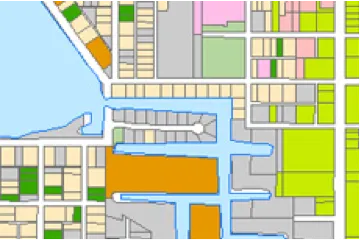Inventory of Suitable Land
Government Code Section 65583(a)(3) requires local governments to prepare an inventory of land suitable for residential development, including vacant sites and sites having the potential for redevelopment, and an analysis of the relationship of zoning and public facilities and services to these sites.
The inventory of land suitable for residential development shall be used to identify sites that can be developed for housing within the planning period (Section 65583.2). This page has been updated to reflect changes pursuant to AB 1397 (Statutes of 2017) and AB 686 (Statutes of 2018).

The purpose of the land inventory is to identify specific sites that are suitable for residential development in order to compare the local government’s regional housing needs allocation (RHNA) with its residential development capacity. The inventory will assist in determining whether there are sufficient sites to accommodate the regional housing need in total, and by income category. A thorough sites inventory and analysis will help the locality determine whether program actions must be adopted to “make sites available” with appropriate zoning, development standards, and infrastructure capacity to accommodate the new construction need. Preparing the site inventory is a two-part process and includes the preparation of a parcel specific inventory of sites (form) and accompanying site suitability analysis. See Analysis of Sites and Zoning. While the following outlines the statutory requirements and factors that are included in the site inventory and analysis, each jurisdiction may have its own unique strategy for addressing its housing need. In addition, while samples and suggestions are included to illustrate how housing element requirements could be met, unless specified in the statute, HCD does not prescribe any one specific methodology in addressing those requirements.
Sites Inventory:
The housing element must identify specific sites or parcels that are available for residential development. Land suitable for residential development must be appropriate and available for residential use in the planning period. Identified sites that require rezoning may be included in the inventory, provided the housing element includes a program to accomplish the rezoning early within the planning period. Other characteristics to consider when evaluating the appropriateness of sites include, physical features (e.g. susceptibility to flooding, slope instability or erosion, or environmental considerations) and location (proximity to transit, job centers, and public or community services). Land suitable for residential development includes all of the following:
- Vacant sites that are zoned for residential development.
- Vacant sites that are not zoned for residential development, but that allow residential development.
- Underutilized sites that are zoned for residential development and capable of being developed at a higher density or with greater intensity.
- Sites that are not zoned for residential development, but can be redeveloped for, and/or rezoned for, residential use (via program actions).
- Sites owned or leased by a city, county, or city and county (If using these types of sites, the element must include a description of whether there are any plans to sell the property during the planning period and how the jurisdiction will comply with the Surplus Land Act Article 8 (commencing with Section 54220) of Chapter 5 of Part 1 of Division 2 of Title 5.
The inventory can also include sites that are in the process of being made available (i.e. planned) for residential uses via rezones or specific plans, provided the housing element includes a program that commits the local government to completing all necessary administrative and legislative actions early in the planning period.
The inventory must include all of the following:
- A parcel-specific listing of sites, using assessor parcel number(s) (APN). Sites identified in the inventory as available to accommodate the RHNA for above moderate-income households, located in areas not served by public sewer systems, need not be listed on a parcel-by-parcel basis.
- The general plan and zoning designations of sites.
- A description of parcel size. This is important as parcel size can be a key factor in determining development viability, capacity and affordability.
- A map showing the location of sites. In terms of scale, a jurisdiction’s general plan land-use diagram or map is appropriate.
- A description of existing uses of any non-vacant sites.
- A description of whether the parcel has available or planned and accessible infrastructure.
- The income category (above moderate-, moderate-, or lower- income) that the site is expected accommodate (see below).
- If the parcel was identified in a previous planning period site inventory (see below).
Please note pursuant to Chapter 667, Statutes of 2019 (SB 6), the site inventory must be prepared using the standards, form, and definitions adopted by HCD. HCD has prepared a form and instructions for this purpose that includes space for the information above, commonly provided fields, and optional fields to include additional information as desired by the jurisdiction. See the “Links” section below for to access the sites inventory form and instructions. Starting January 1, 2021, local governments will need to submit an electronic version of the site inventory to HCD on this form along with its adopted housing element. Electronic sites inventory can be sent to sitesinventory@hcd.ca.gov.
Affirmatively Furthering Fair Housing Sites Requirement
AB 686, Statutes 2018 now requires that a jurisdiction identify sites throughout the community, in a manner that is consistent with its duty to affirmatively further fair housing (AFFH) pursuant to Section 65583(c)(10)(A). In the context of AFFH, the site identification requirement involves not only an analysis of site capacity to accommodate the RHNA, but also whether the identified sites serve the purpose of replacing segregated living patterns with truly integrated and balanced living patterns, transforming racially and ethnically concentrated areas of poverty into areas of opportunity. At the most basic level, this requirement suggests two courses of action relating to the identification of sites:
- Ensure that sites zoned to accommodate housing for lower-income households are not concentrated in lower resource areas and segregated concentrated areas of poverty, but rather dispersed throughout the community, including in areas with access to greater resources, amenities, and opportunity.
- Where sites zoned to accommodate housing for lower-income households are located in lower resource areas and segregated concentrated areas of poverty, incorporating policies and programs in the housing element that are designed to remediate those conditions, including place-based strategies that create opportunity in areas of disinvestment (such as investments in enhanced infrastructure, services, schools, jobs, and other community needs).
Additional technical assistance on fulfilling the sites inventory requirements can be found on HCD’s Affirmatively Furthering Fair Housing page.
Sites by Regional Housing Need Allocation (RHNA) Income Category
The site inventory must specify whether the site or a portion of the site is adequate to accommodate lower income housing, moderate-income housing, or above moderate-income housing. Sites can accommodate units for more than one income category. However, the inventory should indicate the number of units of each income category, and together the total of units attributed to each income category may not exceed total realistic capacity attributed to the site.
Sites Used in Previous Planning Periods Housing Elements
The element must indicate if a site identified to accommodate the low- and very low-income RHNA was used in the previous planning period. Generally, previously identified sites refer to parcels that were identified in a previous housing element’s site inventory to accommodate any portion of any income category of the jurisdiction’s RHNA, as follows:
- For a nonvacant site: Included in a prior planning period’s housing element (e.g., 5th cycle housing element)
- For a vacant site: Included in two or more consecutive planning periods (e.g., 5th cycle and 4th cycle housing element)
If a site was used in a prior housing element cycle per above, then the element must include a program in the housing element requiring rezoning within three years of the beginning of the planning period to allow residential use by right at specified densities (see Zoning to Accommodate the Development of Housing Affordable to Lower-income Households) for housing developments in which at least 20 percent of the units are affordable to lower income households. This program can be an overlay on these specific sites.
Housing Sites Controlled by an Exempt Entity (State, Federal, Tribal Nation)
Sites located on land controlled by exempt entities (e.g. college/university, military, recognized Native American tribes) are different from housing capacity planned on sites controlled by local governments. This is because the local government has no control over the planning and decision-making processes of land within another entity’s boundary, and, therefore, may not be able to demonstrate “sufficient certainty” that housing development on sites controlled by other entities could occur within the planning period to meet (or lessen) the requirement for the local government to identify adequate local sites to meet all of the jurisdiction’s RHNA.<
HCD recognizes that the development of new housing on exempt-entity sites can meet a portion of a local government’s RHNA. For planned housing on exempt-entity sites, HCD allows — on a case-by-case basis — RHNA credit when documentation is provided that demonstrates the likelihood that the planned housing can be developed within the current RHNA/housing element. Adequate documentation varies based on differences in the planning processes on land controlled by exempt federal, state, or tribal entities (and counties in connection with sites within a city’s sphere of influence). Following are examples of documentation to help demonstrate the likelihood of housing being developed on sites near, but outside the control of, a local government:
- Agreement with the entity controlling the land that grants the local government authority regarding approving, permitting, certifying occupancy, and/or reporting new units to the California Department of Finance.
- Documentation from the entity controlling the land that demonstrates planned housing has been approved to be built within the current RHNA cycle. (Note: Short- or long-term housing development budgets or plans typically do not constitute adequate approval, because changes can occur.)
- Data pertaining to project construction and unit affordability by household income category.
- If the site is listed on the Department of General Services Real Estate Excess State Property map located EO N-06-19 Affordable Housing Development webpage.
- The development suitability requirement addressing zoning, density, realistic development capacity, lot size, and existing use(s) must be done on a parcel/site-specific basis.
- Local governments should consult with the for- and nonprofit development community for the purposes of soliciting information about site- and zoning-related factors that are useful in helping to reduce development costs.
- For the purpose of mapping small or scattered housing-opportunity sites (e.g. sites along commercial corridors or within adopted specific plan areas) local governments can use community plan or neighborhood scale maps or aerials.
- To further assist the development community in selecting potential development sites, a local government could post the inventory on its website.
- To ensure the inventory remains a viable and useable land-use planning tool throughout the planning period, local governments should prepare periodic updates (e.g. in conjunction with the annual, general-plan progress report).

